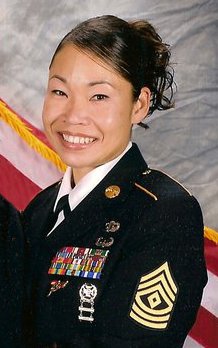Sophia Sweeney, Retired U.S. Army First Sergeant
Credentialing validates the knowledge, skills and abilities of a Service member to both uniformed commanders and potential civilian employers, making it a valuable component of the force education and training strategy within the Department of Defense. The Army increasingly supports and emphasizes certification through policy and funding initiatives, leading to additional demand across the force. Retired First Sergeant Sophia Sweeney has witnessed that growth first-hand as the Army Credentialing Assistance program manager since the program launched in 2018.
How long were you active duty in the Army? What do you do now?
I was in the Army for 20 years as a 31B or Military Policeman. Currently I am an Education Services Specialist performing duties as the Army Credentialing Assistance (CA) and the Army Credentialing Opportunities On-Line (COOL) Program Manager. I’ve been the CA Program Manager since program inception in 2018, and I’ve been the Army COOL Program Manager since 2019.
How would you describe the goal of the Army CA Program?
The goal of the Army CA Program is to improve credentialing opportunities for every eligible Soldier in the entire force. The program complements the Army’s readiness and retention goals, and ultimately helps to validate the acquired knowledge, skills and abilities of the Soldier to the civilian workforce so that they are ready to begin their career when they transition out of the Service.
Have you noticed changes in the Army and the DoD’s emphasize on credentialing?
Over the last couple of years, the DoD, under order from the Secretary of Defense, has changed the focus to really empower and encourage certifications and credentials. Five years ago, it was largely degree-focused, with a lot of emphasis on Tuition Assistance programs. The Army didn’t really support certification financially through the COOL program, focusing instead on promotion points. That has changed over the last few years to really highlight those credentials and certifications, and rightfully so.
Certification is a great chance to pursue something that will not only help you while you are in uniform, but also empower you in your career once you transition out of the military.
—Sophia Sweeney
Tell me about the growth of the CA program over the past couple of years?
The Army CA program began in October 2018, with a Limited User Test (LUT) that included about 28 credentials for active duty Soldiers in Fort Hood, Texas; the National Guard; and the US Army Reserves in Texas. In 2019, we expanded the LUT to include active duty Soldiers in Fort Campbell, KY; the Kentucky National Guard; and the Kentucky reserves, and we opened up the program to all 1600-plus credentials listed in Army COOL. We received requests from all ranks, and all components, which was a big success. In October 2019, we started to phase into a total Army-wide implantation of the CA program, and every month we added more locations. In January 2020, it was opened Army-wide.

What is the biggest obstacle to getting more Soldiers involved with the CA program?
I think one of the biggest obstacles is the lack of marketing that we’re able to do. We don’t have the money to necessarily put out all of the messages that we’d like. We might put information out in certain areas, but we still hear about Soldiers who have no idea that the program was even available to them.
To increase participation, we’ve marketed this program through various digital channels and organizations within the Army that have additional marketing capabilities. Of course, the Education Centers themselves market CA through their locations as well. The best method for getting the information out is to inform the chains of command, but it doesn’t always get back to the lowest level Soldier.

Sophia Sweeney
Where can Soldiers go to get more information about the CA program?
On the Army COOL website, there is an Army Credentialing Assistance tab that provides details about the program, including the step-by-step guide for requesting CA funding, program brochures, and the list of approved vendors that are currently participating. We also refer them to the Education Center because they work with Soldiers on a daily basis.
We always recommend that Soldiers review the criteria to ensure they are even eligible to take a certain credential. If they feel like they meet all of the requirements, then they can look for training to prepare them for the exam and determine how much the exam costs. Then, if they feel comfortable and decide that they want to move forward, they could submit their credentialing assistance request.
How can Education Centers and Test Center Administrators better help Soldiers in their certification journey?
I recommend that they research and learn about the credentials in Army COOL. There is no way to know about all 1500-plus available credentials and their requirements, but if you can identify how to find the information, that is a great start. For example, vendors who provide training don’t always have the information in plain sight, so it’s important to read through the information to see how training can help Soldiers prepare for their exam.
What would you say to Soldiers who are unsure if they should start the certification process?
What a great chance to pursue something that will not only help you while you’re in uniform, but also empower you in your career once you transition out of the military. Certification helps you see your profession from a different perspective. I wish I had this opportunity when I was in the Army. It’s definitely a life-changing experience.